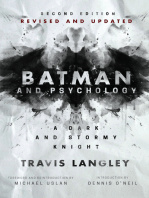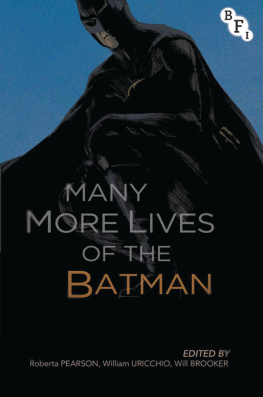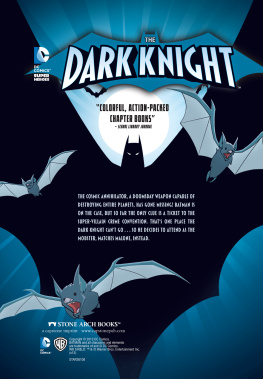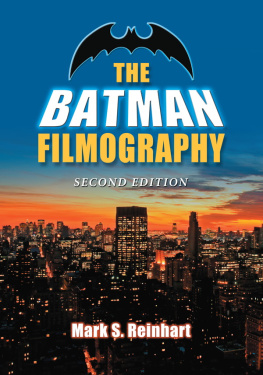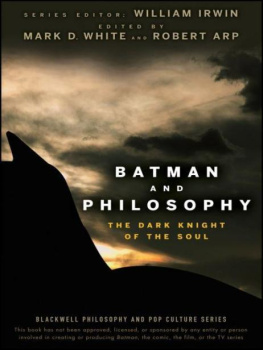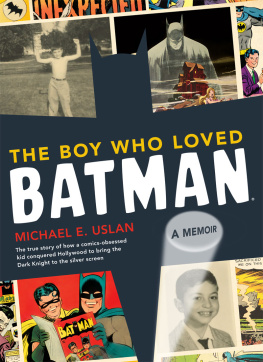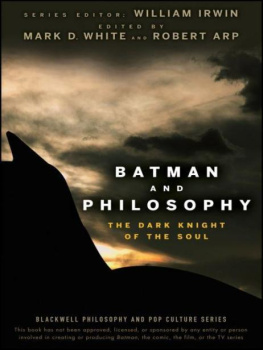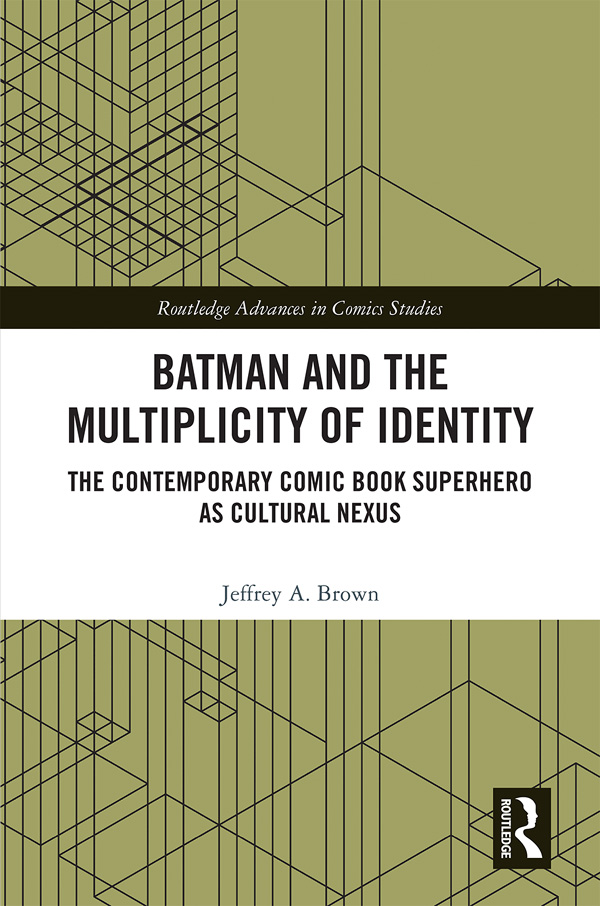
Batman and the Multiplicity of Identity
Concentrating primarily on contemporary depictions of Batman in the comic books, this book analyzes why Batman is so immensely popular right now in America and globally, and how the fictional Dark Knight reveals both new cultural concerns and longstanding beliefs about American values. The organizing premise is that while Batman is perceived as a very clearly defined character, he is open to a wide range of interpretations and depictions in the comics (what Henry Jenkins refers to as multiplicities), each of which allows access to different cultural issues. The idea of Batman functions as an anchoring point out of which multiple Batmen, or Batman-like characters, can occupy different positions: Grim Batman, Gay Batman, Female Batman, Black Batman, Cute Batman, and so on. Each iteration opens up a discussion of different cultural issues pertinent to modern society, such as sexuality, ethnicity, feminism, and familial relationships.
Jeffrey A. Brown is a Professor in the Department of Popular Culture and The School of Critical and Cultural Studies at Bowling Green State University, USA.
Routledge Advances in Comics Studies
Edited by Randy Duncan, Henderson State University
Matthew J. Smith, Radford University
Reading Art Spiegelman
Philip Smith
The Modern Superhero in Film and Television
Popular Genre and American Culture
Jeffrey A. Brown
The Narratology of Comic Art
Kai Mikkonen
Comics Studies Here and Now
Edited by Frederick Luis Aldama
Superman and Comic Book Brand Continuity
Phillip Bevin
Empirical Approaches to Comics Research
Digital, Multimodal, and Cognitive Methods
Edited by Alexander Dunst, Jochen Laubrock, and Janina Wildfeuer
Superhero Bodies
Identity, Materiality, Transformation
Edited by Wendy Haslem, Elizabeth MacFarlane and Sarah Richardson
Urban Comics
Infrastructure & the Global City in Contemporary Graphic Narratives
Dominic Davies
Batman and the Multiplicity of Identity
The Contemporary Comic Book Superhero as Cultural Nexus
Jeffrey A. Brown
First published 2019
by Routledge
52 Vanderbilt Avenue, New York, NY 10017
and by Routledge
2 Park Square, Milton Park, Abingdon, Oxon OX14 4RN
Routledge is an imprint of the Taylor & Francis Group, an informa business
2019 Taylor & Francis
The right of Jeffrey A. Brown to be identified as author of this work has been asserted by him in accordance with sections 77 and 78 of the Copyright, Designs and Patents Act 1988.
All rights reserved. No part of this book may be reprinted or reproduced or utilised in any form or by any electronic, mechanical, or other means, now known or hereafter invented, including photocopying and recording, or in any information storage or retrieval system, without permission in writing from the publishers.
Trademark notice: Product or corporate names may be trademarks or registered trademarks, and are used only for identification and explanation without intent to infringe.
Library of Congress Cataloging-in-Publication Data
A catalog record for this title has been requested
ISBN: 978-1-138-30285-3 (hbk)
ISBN: 978-0-203-73166-6 (ebk)
Typeset in Sabon
by codeMantra
For my Mother, Janet Brown, who bought me my first comic book.
(and Alex)
He is the Dark Knight, the Caped Crusader, The Worlds Greatest Detective, the Guardian of Gotham, and the Masked Manhunter. He is also one half of the Dynamic Duo, The Worlds Finest, and The Brave and the Bold. He is a founding member of The Justice League and The Outsiders. He is the Batmanone of the most famous, beloved, and profitable fictional characters in the world. Since his first appearance in Detective Comics #27 in 1939, Batman has remained a best-selling comic book character as well as a star of live-action blockbuster films and campy television series, Saturday morning cartoons, animated direct-to-video movies, novels, video games, and even musical theater. Batman has also proven to be a merchandising bonanza generating billions of dollars through toys, action figures, T-shirts, pajamas, coffee mugs, lunchboxes, watches, shoes, and just about anything else that Batmans face or the bat symbol can be put on. Created by Bob Kane and Bill Finger just months after Supermans debut launched the superhero genre, Batman is more popular than ever after 80 years of continuous adventures.
Batman has become an incredibly important cultural figure. Very few other fictional characters (or real people) are as well known as the Caped Crusader. No other superhero has their own international day of recognition. Since 2014, the third Saturday in September has become Batman Day, an annual promotional campaign instituted by media conglomerate Time-Warner to leverage one of the companys most successful properties. The day is a celebration of all things Batman, with special sales on DC Comics, graphic novels, movies, toys, clothing, and hundreds of Batman-related products. Stores hold special events with children and adults alike, encouraged to dress up as Batman or one of his famous allies or enemies. Very few other popular culture figures would be able to sustain an annual day of international celebration (the Star Wars universe as a whole is the only other similar event). But something about Batman appeals to people around the world, regardless of age, ethnicity, gender, sexuality, or other differences. By most measures, Batmans status as the most popular superhero is consistently demonstrated. In 2009, the website Fandom Mania rated the 100 greatest fictional characters with Batman ranked as #1 (Dorough, 2009). In 2012, Entertainment Weekly had readers vote in a massive bracket-style Superhero Showdown contest that saw Batman declared the definitive fan favorite (Franich, 2012). Wired.com reported in 2013 that Batman was the most searched for character on YouTube (Watercutter, 2013). According to CNBC, Batman comic book sales and searches outrank all others on eBay (DiChristopher, 2015). Retail evaluator Slice Intelligence revealed in 2018 that Batman merchandise dominates online superhero sales, accounting for 28% of all salesSpider-Man was a distant second with 13.5% (Stanton, 2018). The Observer also reported that Batman outranks all other superheroes in a number of movie and television appearances (Katz, 2018). Clearly, something about Batman, this Dark Knight, defined by tragedy and a relentless pursuit of violent justice, speaks to both personal and cultural desires.
This book is concerned with the various ways that the figure of Batman reflects and shapes cultural perceptions about numerous important and contentious issues, including familial relations, sexuality, ethnic representation, violence and morality, as well as mass-mediated intertextuality and consumerism. What, in other words, does an incredibly popular fictional character who runs around in bat-themed costume reveal about our personal and cultural beliefs? The underlying premise of this book is that Batman serves as a cultural nexus, a connecting point, that communicates and grounds shifting and sometime amorphous ideologies within contemporary society. Batman is one of the ways that we learn social rules and incorporate them into our personal belief systems. Batman might be discounted by some critics as mere fluff, part of inconsequential popular culture, a silly figure in a silly suit beating up cartoonish villains for the entertainment of children and childish adults. But his enduring popularity and the seemingly omnipresent Bat symbol suggest an important cultural purpose. In their groundbreaking 1991 work on Batman, Uricchio and Pearson insightfully argue that the character is an agent of hegemony: that he functions textually as an agent of political domination and extra-textually as both supporter of the hegemonic order and a commodity form (p. 207). Specifically, Uricchio and Pearson were concerned with how Batman demonstrated the value of maintaining the status quo in relation to class, wealth, and property rights. Throughout this book, I want to build on Uricchio and Pearsons argument to consider how Batman also constructs, reinforces, and challenges dominant ideas beyond his core mission of fighting criminals to enforce modern property laws and a specific notion of justice.
Next page


